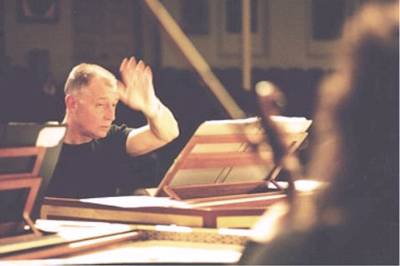by Jeremy Reynolds

Jeremy Reynolds: I understand that BPI was a revelatory experience for you. When did you first begin your affiliation with the institute?
Webb Wiggins: In the late 1970s. I came in as a student — a keyboardist — and that was where I had my first experience performing as a harpsichordist. It was really life changing! So I went home and decided “this is my life.” I’ve been involved in BPI almost every summer since then, first as a returning student, then as assistant faculty, and then I found out I was a faculty member — even though I’d never actually been appointed. This was at least twenty years ago, while I was still teaching early music at Peabody.
JR: I’ve heard that BPI has slowly moved away from attracting mainly amateurs.
WW: I think that’s pretty true, and that’s been the case with early music playing in general. Everybody was an amateur to begin with, and the level was not great. When I first came to BPI, a large number of older adults came for the summer camp to play for fun. Now, I would say we’re pretty well beyond that. There are older adults who come, who may not play very well, but they’re professional musicians in their own right. The general editor for the CPE Bach editions comes, and — my god — she know a hell of a lot, and she does her best.
JR: Do any of your students from Peabody or Oberlin attend?
WW: Practically every accompanist we’ve got is a former student of mine, and practically every student I’ve had who was a harpsichord major at Oberlin has come and participated at least once.
JR: What’s your take on BPI’s theme this year?
WW: We divide baroque music between the 17th and 18th centuries. 1690 is that bridge time, when you start actually dealing with functional harmony. Back in the 17th century, harmony was more of a result than a function — music was not based on harmonic progression at that time, it was still coming out of counterpoint. Jean-Phillipe Rameau (1683 – 1764) thought that a chord progression should lead somewhere, and that a bad progression wouldn’t do that. When we get to the 18th century, we arrive at recognizable harmonic functions. And we still use those progressions today in modern everyday music.
JR: Will your students perform in any of this year’s fringe concerts?
WW: Marilyn McDonald is programming the complete Corelli Trio Sonatas on two separate fringe concerts — likely Thursday of each week. For those twelve sonatas, I have to find twelve keyboard players, and Cathy Meints has to find 12 bass players. That makes these things a bit complicated! Last year, we performed all of the obbligato Bach sonatas for violin, flute, and viola de gamba. I actually had fifteen spreadsheets going at once to keep all of the performers organized. I’m not the point person this year, but I will be organizing which keyboard students perform in which pieces.
JR: Will you be performing in any of the sonatas?
WW: (laughs) I hope not! I love playing Corelli sonatas — they’re some of the finest music ever written. The idea is to have our students play as much as they can, but we don’t want to overload them. We have five or six students each week learning new music every night to accompany master classes in the morning, but to couple that with learning trio sonatas may be too much. So it’s quite possible that I’ll step in and perform a couple.
JR: Do the keyboard students have the opportunity to perform solo repertoire during BPI?
WW: The harpsichordists usually play continuo accompaniment, but we may try and find a fringe concert time for them to perform what they’ve been working on in their masterclasses and show off a little bit.
Published on ClevelandClassical.com June 22, 2015.
Click here for a printable copy of this article


